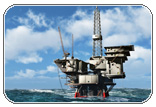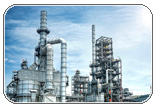Digitization of the camera system of an offshore platform in the South Atlantic

Ex-protected-IP-cameras from SAMCON, replace old analog systems
Requirement
The analogue camera system that has been in place for years on one of the largest offshore platforms in the South Atlantic should be modernized and brought up to date with the latest technology using new explosion-proof digital cameras and connection technology. Both the hardware and the software for visualizing and recording the camera images should be renewed in this context. Our Ex camera systems ensure safety in potentially explosive environments and withstand the harsh conditions at sea. They are resistant to a wide range of media, corrosion-resistant, IP66 and IP68 protected and oil-resistant.
Some parts of the old infrastructure should be incorporated into the new concept due to the high cost of renewal. For this reason, a technology was chosen that transmits the videos from the new cameras over the old analog cables.
Project planning
In our project, dome cameras were used for a 360° all-round view, as well as motor zoom cameras with a wiper and additional cleaning system (Wash & Wipe). Since the old system consisted of analog cameras connected via coaxial cable, Ex connection units were built that converted the new digital camera signal so that the coaxial cable in the old hybrid cable could continue to be used. A connection unit was provided for each camera, which, in addition to the network, also provides a power supply to power the cleaning unit, the smart.Cleaner, for the zoom cameras.
The camera images are recorded on a server and visualized via several client stations in different areas on the platform. You can choose to access all cameras or just individual ones. Corresponding rights to the respective video walls were set up using different user profiles. It is operated via connected joysticks to make it as easy as possible to use the PTZ function of the dome cameras.
The system was designed with sufficient reserves so that additional cameras can be connected. Care was also taken to ensure that the analog cables could be replaced with fiber optic cables in the future. This means that the entire infrastructure will be up to date for the next few years and can be expanded accordingly.
Conclusion
During project planning it became clear that, thanks to the current possibilities of transmission technologies, it is not always necessary to completely replace the old infrastructure, but rather to integrate it. The high-resolution videos of the new camera system, which deliver significantly better image quality than the analog system, make it possible to monitor the explosive environment more efficiently.
Oil drilling platforms are dangerous working environments with a high risk of accidents. Cameras monitor critical areas and help detect accidents early and respond quickly to prevent injuries or deaths. In the event of an accident or disaster, such as a fire or blowout, surveillance cameras provide valuable real-time information, critical to rapid and effective emergency response and evacuation. Cameras can continuously monitor operations and ensure all safety protocols are being followed to identify potential hazards before they cause serious problems.
In summary, video surveillance on oil drilling platforms contributes significantly to (occupational) safety, efficiency and environmental responsibility by providing continuous monitoring and rapid response options to critical events.




